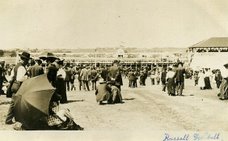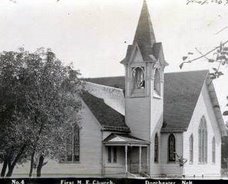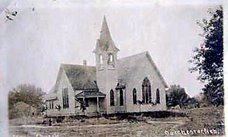skip to main |
skip to sidebar
NEWS BRIEFS: DHS Graduate Is President-Elect Of Neb. Architects Group
 DHS Grad Kristi Nohavec Elected Next President of Nebraska Architects: AIA Nebraska, a Society of the American Institute of Architects, has announced the election of its 2009 Board of Directors, including the organization's President-Elect Kristi Nohavec who is employed by the Clark Enersen Partners, Inc. Nohavec is a 1989 graduate of DHS and currently resides in Lincoln. "The American Institute of Architects is the voice of the architectural profession and the resource for its members in service to society," according to the organization's Web site. Last year, Nohavec was honored with the Midlands Business Journal's "40 under 40" award. She gave back to her hometown by designing the new shelter in the Dorchester City Park. We at the Times tip our hats to Kristi for her accomplishments in her young career.
DHS Grad Kristi Nohavec Elected Next President of Nebraska Architects: AIA Nebraska, a Society of the American Institute of Architects, has announced the election of its 2009 Board of Directors, including the organization's President-Elect Kristi Nohavec who is employed by the Clark Enersen Partners, Inc. Nohavec is a 1989 graduate of DHS and currently resides in Lincoln. "The American Institute of Architects is the voice of the architectural profession and the resource for its members in service to society," according to the organization's Web site. Last year, Nohavec was honored with the Midlands Business Journal's "40 under 40" award. She gave back to her hometown by designing the new shelter in the Dorchester City Park. We at the Times tip our hats to Kristi for her accomplishments in her young career.
- DHS Grad Kayla Stehlik Earns Volleyball Accolades From Morningside College: According to the Sioux Cit
 y Journal, 2007 Dorchester High School graduate Kayla Stehlik was named Morningside College's most improved improved player for the school's 2008 junior varsity volleyball team. In addition to the most improved player award, the 5-10, sophomore outside hitter was also honored with the team's JV hustle award during Morningside's post-season awards banquet, which was held last Sunday. As a senior at DHS, Stehlik was named to the Lincoln Journal Star's Class D1 All State Honorable Mention volleyball squad in late 2006, along with her classmate Amanda Hochstetler. Morningside's varsity team was an NAIA national tournament qualifier during the 2008 season and finished 37-6 overall, according to the team's Web site. We congratulate Kayla for her honors and hard work. To see more on Morningside College volleyball, click here.
y Journal, 2007 Dorchester High School graduate Kayla Stehlik was named Morningside College's most improved improved player for the school's 2008 junior varsity volleyball team. In addition to the most improved player award, the 5-10, sophomore outside hitter was also honored with the team's JV hustle award during Morningside's post-season awards banquet, which was held last Sunday. As a senior at DHS, Stehlik was named to the Lincoln Journal Star's Class D1 All State Honorable Mention volleyball squad in late 2006, along with her classmate Amanda Hochstetler. Morningside's varsity team was an NAIA national tournament qualifier during the 2008 season and finished 37-6 overall, according to the team's Web site. We congratulate Kayla for her honors and hard work. To see more on Morningside College volleyball, click here.
- Just Hot Air?: The Lincoln Journal Star is reporting Saline County "could become the wind capital of
 Nebraska." In an article by reporter Algis J. Laukatis, we are told "several companies (including a British business) are interested in developing wind farms in the central and western parts of the county, and some landowners were already contacted to sign long-term contracts to place wind towers on their land" and that a landowner could earn $2,000 to $14,000 in annual payments for each turbine." While wind turbines in our area might be great for property tax revenues, no mention is made of how such wind farms could increase Nebraska electricity rates, which are currently eighth lowest in the nation. Moreover, no mention is made of what rights adjacent landowners would have when it come to the obstructive views or noise caused by the wind farms -- or what the impact would be of transmission lines crossing the county in order to connect the turbines, which produce little electricity compared to coal, nuclear or even hydro-powered generators. Saline County residents can find out more about the wind projects -- and voice their support or opposition -- by attending upcoming 7 p.m. meetings at Saline Center on the following dates: Jan. 15; Jan. 17; Jan. 22; Jan. 26.
Nebraska." In an article by reporter Algis J. Laukatis, we are told "several companies (including a British business) are interested in developing wind farms in the central and western parts of the county, and some landowners were already contacted to sign long-term contracts to place wind towers on their land" and that a landowner could earn $2,000 to $14,000 in annual payments for each turbine." While wind turbines in our area might be great for property tax revenues, no mention is made of how such wind farms could increase Nebraska electricity rates, which are currently eighth lowest in the nation. Moreover, no mention is made of what rights adjacent landowners would have when it come to the obstructive views or noise caused by the wind farms -- or what the impact would be of transmission lines crossing the county in order to connect the turbines, which produce little electricity compared to coal, nuclear or even hydro-powered generators. Saline County residents can find out more about the wind projects -- and voice their support or opposition -- by attending upcoming 7 p.m. meetings at Saline Center on the following dates: Jan. 15; Jan. 17; Jan. 22; Jan. 26.
 DHS Grad Kristi Nohavec Elected Next President of Nebraska Architects: AIA Nebraska, a Society of the American Institute of Architects, has announced the election of its 2009 Board of Directors, including the organization's President-Elect Kristi Nohavec who is employed by the Clark Enersen Partners, Inc. Nohavec is a 1989 graduate of DHS and currently resides in Lincoln. "The American Institute of Architects is the voice of the architectural profession and the resource for its members in service to society," according to the organization's Web site. Last year, Nohavec was honored with the Midlands Business Journal's "40 under 40" award. She gave back to her hometown by designing the new shelter in the Dorchester City Park. We at the Times tip our hats to Kristi for her accomplishments in her young career.
DHS Grad Kristi Nohavec Elected Next President of Nebraska Architects: AIA Nebraska, a Society of the American Institute of Architects, has announced the election of its 2009 Board of Directors, including the organization's President-Elect Kristi Nohavec who is employed by the Clark Enersen Partners, Inc. Nohavec is a 1989 graduate of DHS and currently resides in Lincoln. "The American Institute of Architects is the voice of the architectural profession and the resource for its members in service to society," according to the organization's Web site. Last year, Nohavec was honored with the Midlands Business Journal's "40 under 40" award. She gave back to her hometown by designing the new shelter in the Dorchester City Park. We at the Times tip our hats to Kristi for her accomplishments in her young career. y Journal, 2007 Dorchester High School graduate Kayla Stehlik was named Morningside College's most improved improved player for the school's 2008 junior varsity volleyball team. In addition to the most improved player award, the 5-10, sophomore outside hitter was also honored with the team's JV hustle award during Morningside's post-season awards banquet, which was held last Sunday. As a senior at DHS, Stehlik was named to the Lincoln Journal Star's Class D1 All State Honorable Mention volleyball squad in late 2006, along with her classmate Amanda Hochstetler. Morningside's varsity team was an NAIA national tournament qualifier during the 2008 season and finished 37-6 overall, according to the team's Web site. We congratulate Kayla for her honors and hard work. To see more on Morningside College volleyball, click here.
y Journal, 2007 Dorchester High School graduate Kayla Stehlik was named Morningside College's most improved improved player for the school's 2008 junior varsity volleyball team. In addition to the most improved player award, the 5-10, sophomore outside hitter was also honored with the team's JV hustle award during Morningside's post-season awards banquet, which was held last Sunday. As a senior at DHS, Stehlik was named to the Lincoln Journal Star's Class D1 All State Honorable Mention volleyball squad in late 2006, along with her classmate Amanda Hochstetler. Morningside's varsity team was an NAIA national tournament qualifier during the 2008 season and finished 37-6 overall, according to the team's Web site. We congratulate Kayla for her honors and hard work. To see more on Morningside College volleyball, click here. Nebraska." In an article by reporter Algis J. Laukatis, we are told "several companies (including a British business) are interested in developing wind farms in the central and western parts of the county, and some landowners were already contacted to sign long-term contracts to place wind towers on their land" and that a landowner could earn $2,000 to $14,000 in annual payments for each turbine." While wind turbines in our area might be great for property tax revenues, no mention is made of how such wind farms could increase Nebraska electricity rates, which are currently eighth lowest in the nation. Moreover, no mention is made of what rights adjacent landowners would have when it come to the obstructive views or noise caused by the wind farms -- or what the impact would be of transmission lines crossing the county in order to connect the turbines, which produce little electricity compared to coal, nuclear or even hydro-powered generators. Saline County residents can find out more about the wind projects -- and voice their support or opposition -- by attending upcoming 7 p.m. meetings at Saline Center on the following dates: Jan. 15; Jan. 17; Jan. 22; Jan. 26.
Nebraska." In an article by reporter Algis J. Laukatis, we are told "several companies (including a British business) are interested in developing wind farms in the central and western parts of the county, and some landowners were already contacted to sign long-term contracts to place wind towers on their land" and that a landowner could earn $2,000 to $14,000 in annual payments for each turbine." While wind turbines in our area might be great for property tax revenues, no mention is made of how such wind farms could increase Nebraska electricity rates, which are currently eighth lowest in the nation. Moreover, no mention is made of what rights adjacent landowners would have when it come to the obstructive views or noise caused by the wind farms -- or what the impact would be of transmission lines crossing the county in order to connect the turbines, which produce little electricity compared to coal, nuclear or even hydro-powered generators. Saline County residents can find out more about the wind projects -- and voice their support or opposition -- by attending upcoming 7 p.m. meetings at Saline Center on the following dates: Jan. 15; Jan. 17; Jan. 22; Jan. 26.

















































Congrats to the girls.
ReplyDeleteAbout the wind farm, if I have to stare at something like that, I'll be moving. Utterly ridiculous.
I always get the "feeling" that the Times is against the wind farm project.
ReplyDeleteWhat is so wrong with the wind farms. It is a clean way of getting energy. What is so wrong with that?
ReplyDeleteThe populist press corps has painted a rosy of wind energy, which is the darling child of lefty groups like the Farmers Union and others who hope to live off government subsidies. What they don't tell you is that in order for wind to generate enough power to replace a typical power plant, it would take up to 300 square miles of wind turbines. That is the size (and view) of New York City for one wind farm!
ReplyDeleteI listen to a nationally syndicated radio show called "Money Talk" on the weekends. It's pretty fair and straight down the middle politically. A few weeks ago, they interviewed a well recognized and respected energy expert named Charlie Maxwell. They asked Charlie to comment on using wind energy to combat the energy crises. Charlie said the first problem is the wind doesn't always blow. (Reminds me of Saline County on a hot, steamy July or August night.) Sometimes when you have heavy hot spots, there isn't wind for a long period of time and you have to replace that energy with coal or some other fuel. You would have to build that extra capacity because you never know when you would need it. Plus, it takes a lot of energy to make the infrastructure for wind energy, and there are other problems with it, such as birds that get killed in the propellers. People also don't like the noise they make. And there aren't many places to build them. Even when they do produce electricity, the wind farms are often in areas that they would need to transport the energy produced to where it is needed. Charlie said we are working on superconductor transmission lines, but that is probably 20-30 years away.
Charlie pointed out that if the U.S. really wants to produce "cleaner" energy and not bankrupt people with energy bills, it must pursue more nuclear energy (like France, which is 90% nuclear) and develop coal-to-liquid plants, since the U.S. has an estimated 350 years of coal supply.
Forget the longhorns............................................... just call us the dorchester turbines............ or the don quixote's
ReplyDeleteOf course we could just do nothing and return back to the 19th century when the oil runs out.
ReplyDeleteIf the wind does not blow for a week out of a Nebraska year, it would be dramatic.
I would be proud to have one in my back yard. Every pivot corner should have one.
I understand they are expensive, but what would you rather have, electricity or nothing.
If we get a big solar storm, we may just get a taste of "no energy" when all our communications goes down, and all the computer curcuit boards get fried. Those wind turbines may be the only thing that get us back on track after that!
JR Wolfe
I'd rather have cheap electricity.
ReplyDeleteWhat is wrong with the way we generate electricity now? If someone mentions global warming, I'm going to have Cynical Richard get his gun.
When the sea level goes up 40 feet from the melting ice caps and you idiots all drown the world will be a better place. The time for new ideas is now.
ReplyDeleteIf California and New York go underwater, we'll all be better off!
ReplyDelete